Grocery stores have retooled in recent years to gain back market share lost to restaurants. They’re making an aggressive play at clawing back customers by offering services and products from the restaurant playbook – and more and more, the lines between the two are starting to blur. The stage is set for a new chapter in the decades-old stomach wars. But does the restaurant industry see it coming?
Stomach Wars: From Ancient Grudge to New Mutiny
Think of today’s restaurant industry like warring villages in ancient times. QSR and Casual Dining are two established towns preoccupied with the shiny new neighboring village, Fast Casual, who’s growing so rapidly that territory wars are imminent. Their citizens exchange some heated words, watch each other closely, and focus entirely on the threat the others pose to their turf.
Then, all of a sudden, Attila the Hun – grocery stores in our example – comes along and plunders all the villages. They’re completely unprepared for the attack because they were so focused on each other.
Okay, that example might be a bit dramatic. But restaurants need to know that grocery stores are real contenders. Restaurants don’t view grocery stores as a valid threat – in fact, they’re not even on the radar – due to decades of easily earned market share growth and more clearly defined market segments in the past.
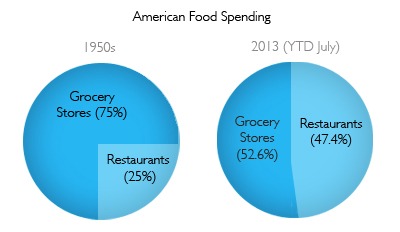
The battle for American food dollars is deep-rooted in the United States’ history. Before the 1900s, most Americans spent 10 times more on grocery store/retail food purchases than on restaurant purchases. As incomes increased, so did restaurant spending. By the 1950s, food retailing made up 75 percent of the American food budget and 25 percent went to dining out.
Over the past half a century, many factors narrowed the gap in the United States. Women’s liberation and the civil rights movement dramatically altered the playing field, pulling more people into the workforce, and shattering the gender norms that kept many women at home cooking meals for the family. Technological advancements sped up the pace of everyday life. The convenience and overall experience restaurants provided were alluring to busy, fast-paced Americans. Average incomes increased. As a result, food expenditures are now close to an even split. In 2013 (year-to-date through the month of July), 52.6 percent of the average food budget was spent on food retail and grocery store purchases, while 47.4 percent was spent eating away from home
Grocery stores are tired of losing ground. So they’re fighting to claw back customers and market share by competing more directly with restaurants as – essentially – restaurants.
Grocery Stores Mimic Restaurants
As grocery stores lost more market share, a few chains realized they needed to innovate or perish. They took cues from other industries – like designing window displays and developing merchandising techniques from the fashion world. And, of course, they looked at restaurants.
As early as the 1970s, grocery stores and other food retail companies have wanted to put their hat in the restaurant ring. A few brave early adopters like Whole Foods, Wegman’s, and Publix began to experiment with in-store dining operations to provide home meal replacements and new value to their customers. They realized, with the unspoken undercurrent of ever-rising food prices, relying on discounts just wasn’t going to cut it. (Unlike Albertsons – which remains hooked up on life support in case you’re wondering.)
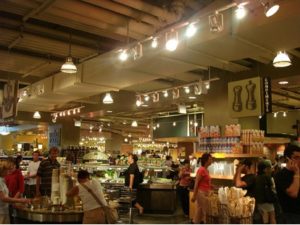
Source: Flickr. MidtownLunch.
Whole Foods Market, well known as the world leader among grocery store chains in natural and organic foods, positioned the “fresh” and “authentic” aspects of their brand even further by offering food stations throughout their stores, including regional dishes made from wholesome ingredients.
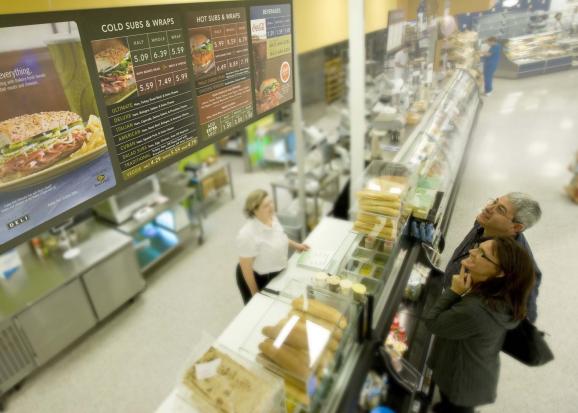
Source: WUSF News
Publix, the Southern American grocery chain “where shopping is a pleasure,” took their service-oriented message and created what their family-focused, busy customers craved: ready-to-eat meals like rotisserie chicken, fried chicken, seafood, deli meats, salads, sides, and their beloved sandwiches. (There’s a tumblr account dedicated to “Pub Subs.” Even Buzzfeed declared their subs a heavenly, religious experience.) Publix saw such positive year-over-year growth that they continued to experiment and invest in further developments. Some Publix locations have full cafés with ample seating and even serve different ethnic cuisines.
The past decade saw intense growth for the early adopters. It paved the way for other grocery stores to follow suit. They’ve waited in the wings for a while now, but they’re finally ready to take the stage as major contenders for America’s food dollar.
The Keys to Their Success
Why do guests gravitate toward these concepts – concepts that would’ve seemed foreign and comparatively poorly executed mere decades ago? Well, there are a few key reasons:
1. The Perception of Being Healthy
The options available at grocery stores are perceived as fresh, ecologically responsible, sustainable, and in many cases locally sourced. You can’t beat the psychological association you get as you order a meal standing next to – for example, a well-organized display of perfectly ripe golden delicious apples.
2. Low Hassle
Families are busy, stressed, and on a budget. Grocery stores took a page out of the restaurant playbook that succeeded in claiming them more market share – convenience. As the saying goes, “In business, you can never make it too easy to buy from you.” There’s no fuss when you’re already doing your grocery shopping and then decide to take away a family portion of chicken sandwiches and potato salad from the deli counter. No worrying about little Johnny’s restaurant etiquette. No fretting over how much to leave for a tip. Grocery stores are succeeding at providing main courses that are easily paired with a number of sides. It’s just less hassle when families are picking up their weekly necessities to grab dinner while they’re already there.
Battle Lines Blur for Restaurants and Grocery Stores
Want to build your fort against the Huns? Keep in mind what helped restaurants gain market share in the first place: convenience, experience, and service. Two ways restaurants can exemplify those values while counteracting grocery stores’ aggressive plays are also ways that show how the lines between grocery stores and restaurants are blurring: selling family meals and creating branded retail products for grocery store shelves.
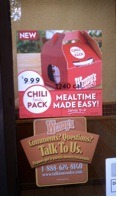
Source: Supermarket Eats
Creating family-size meals directly competes with grocery stores’ competitive family-centered positioning. A few notable examples of successful family portions are Mimi’s Café’s Family Meals To Go, Bob Evans’ Family Meals To Go (which are only available for takeaway), Buona Beef family meals, and Wendy’s chili family pack.
Another way is selling restaurant-branded products in retail environments. The thought process is that customers already recognize and trust the restaurant brand. If consumers can purchase the restaurant’s products in a grocery store setting, it reinforces the brand recognition and trust even further, so that when they do decide to spend their dining-out dollars, they’ll return to that restaurant.
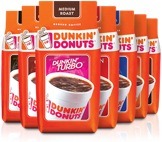
Source: Dunkin’ At Home Coffees
A few successful examples include Starbucks coffee, Starbucks ice cream, Burger King apple fries, California Pizza Kitchen pizzas, Dunkin’ Donuts coffee, T.G.I. Friday’s mozzarella sticks and potato skins, and Taco Bell “hot restaurant” sauce.
How successful are such products? In a recent study, 77 percent of people indicated having bought restaurant-branded products from the grocery store. Respondents with household incomes between $75,000 and $99,000 reported as being “significantly more likely to buy restaurant brands.”
The key is not to cannibalize sales by offering the same products you can get in stores, such as offering frozen versions of popular menu items.
Cracker Barrel, for example, avoids that dilemma by offering limited-time items, small quantities of items, and items not sold in restaurants as retail products. Below is Cracker Barrel’s limited-time seasonal “Pumpkin Pecan Pie Coffee.”

Source: The Petite Athleat.
How to Hit Them Where It Hurts
Most statistical forecasts show grocery stores are perched and poised to gain major ground in the foodservice market. Through 2022, prepared food purchased at grocery stores will increase by 10 percent, compared to the 4 percent growth forecasted for restaurants.
Again, restaurants need to remember how they’ve excelled in the past and how they can really shine in important areas: customization, convenience, and quality.
1. Customization
Consumers do not think of grocery store options as customizable. A mere 38 percent of people believe grocery stores provide more food customization options than a restaurant does – and the other 62 percent majority is completely right. Restaurants still have the edge in being able to prepare food exactly as consumers want it – especially in the ever-growing fast-casual sector.
2. Convenience
Grocery stores aren’t considered convenient unless the consumer already happens to be there. Statistically, customers rarely head over to grocery stores with the sole intention of getting a prepared dinner.
3. Quality
Even though nearly 50 percent of consumers think food quality at grocery stores has “greatly improved” since 2010, about 40 percent of consumers would like name-brand foods at grocery or retail restaurants, which – in less polite terms – translates to wishing the food were higher quality.
Key Takeaway
To succeed in the battle against grocery stores, above all else, restaurants need to communicate their value: restaurants excel in the areas of convenience, experience and service. But there’s a fourth value that should be the most important of all – innovation.
When was the last time you held a meeting to discuss how your restaurant could give a little something extra to your guests?
Just as grocery stores innovated and clawed back market share by taking a page out of the restaurant industry’s book, it’s your turn to innovate to keep your market share firmly in your pocket.
But it goes beyond numbers, ROI, and bean-counting.
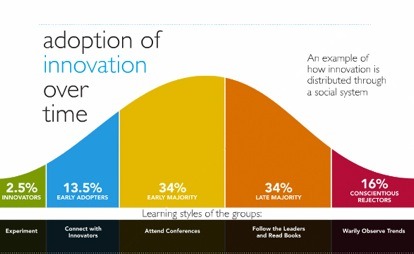
Go the extra mile in convenience, service and guest experience to guard your market share. Be an innovator in the 2.5% of the social system bell curve above. Make a miracle. Do what is spectacular and memorable. Take time to innovate before you’re forced to because it has become the industry standard, and do more than what is required or mandatory. It will be your surprise attack, and Attila won’t know what hit him.

